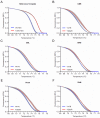FXN Promoter Silencing in the Humanized Mouse Model of Friedreich Ataxia
- PMID: 26393353
- PMCID: PMC4579136
- DOI: 10.1371/journal.pone.0138437
FXN Promoter Silencing in the Humanized Mouse Model of Friedreich Ataxia
Abstract
Background: Friedreich ataxia is caused by an expanded GAA triplet-repeat sequence in intron 1 of the FXN gene that results in epigenetic silencing of the FXN promoter. This silencing mechanism is seen in patient-derived lymphoblastoid cells but it remains unknown if it is a widespread phenomenon affecting multiple cell types and tissues.
Methodology / principal findings: The humanized mouse model of Friedreich ataxia (YG8sR), which carries a single transgenic insert of the human FXN gene with an expanded GAA triplet-repeat in intron 1, is deficient for FXN transcript when compared to an isogenic transgenic mouse lacking the expanded repeat (Y47R). We found that in YG8sR the deficiency of FXN transcript extended both upstream and downstream of the expanded GAA triplet-repeat, suggestive of deficient transcriptional initiation. This pattern of deficiency was seen in all tissues tested, irrespective of whether they are known to be affected or spared in disease pathogenesis, in both neuronal and non-neuronal tissues, and in cultured primary fibroblasts. FXN promoter function was directly measured via metabolic labeling of newly synthesized transcripts in fibroblasts, which revealed that the YG8sR mouse was significantly deficient in transcriptional initiation compared to the Y47R mouse.
Conclusions / significance: Deficient transcriptional initiation accounts for FXN transcriptional deficiency in the humanized mouse model of Friedreich ataxia, similar to patient-derived cells, and the mechanism underlying promoter silencing in Friedreich ataxia is widespread across multiple cell types and tissues.
Conflict of interest statement
Figures




References
-
- Bidichandani SI, Delatycki MB. Friedreich Ataxia. In: Pagon RA, Adam MP, Ardinger HH, Wallace SE, Amemiya A, Bean LJH, et al., editors. GeneReviews(R). Seattle (WA)1993 [updated 2014]. - PubMed
-
- Campuzano V, Montermini L, Molto MD, Pianese L, Cossee M, Cavalcanti F, et al. Friedreich's ataxia: autosomal recessive disease caused by an intronic GAA triplet repeat expansion. Science. 1996;271(5254):1423–7. - PubMed
Publication types
MeSH terms
Substances
Grants and funding
LinkOut - more resources
Full Text Sources
Other Literature Sources
Medical
Molecular Biology Databases
Miscellaneous

